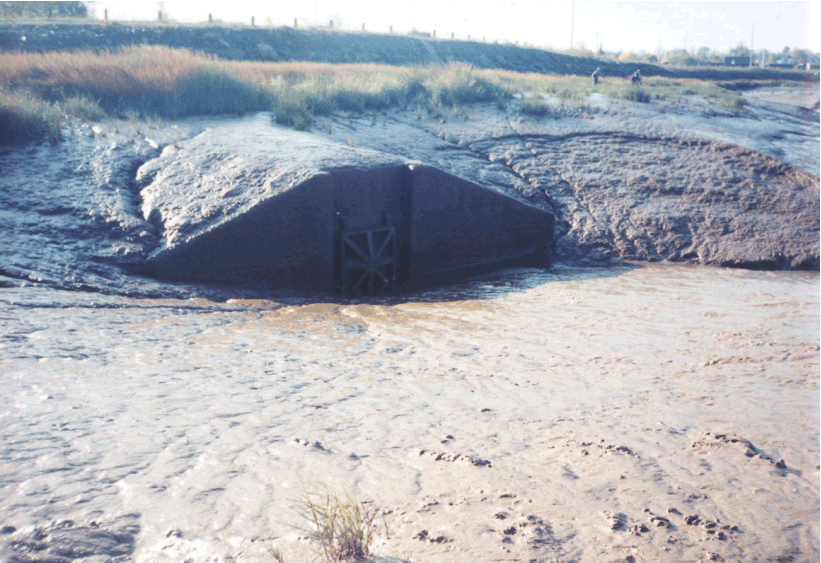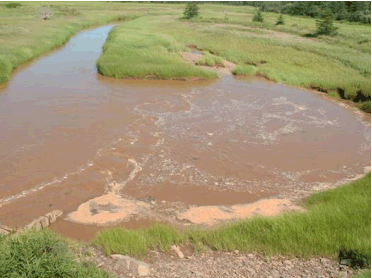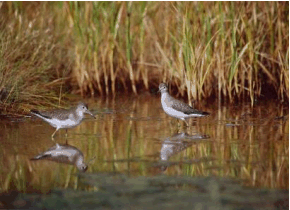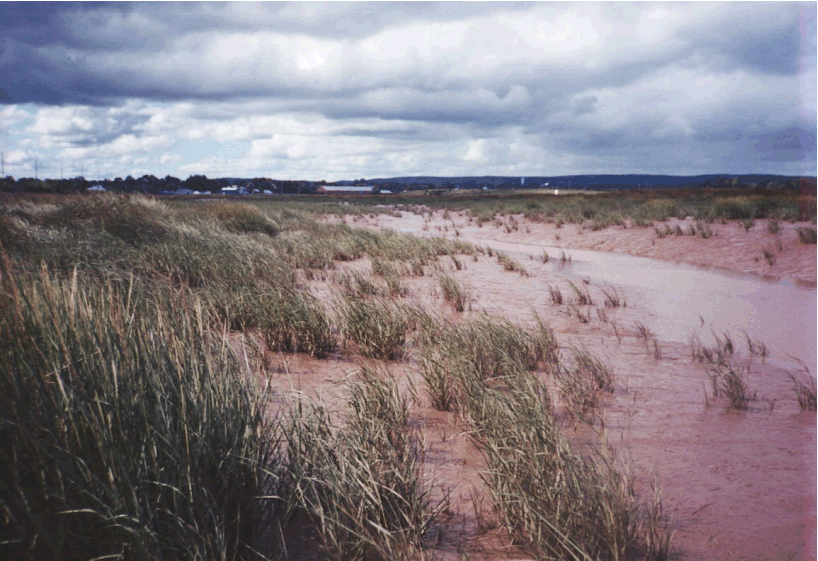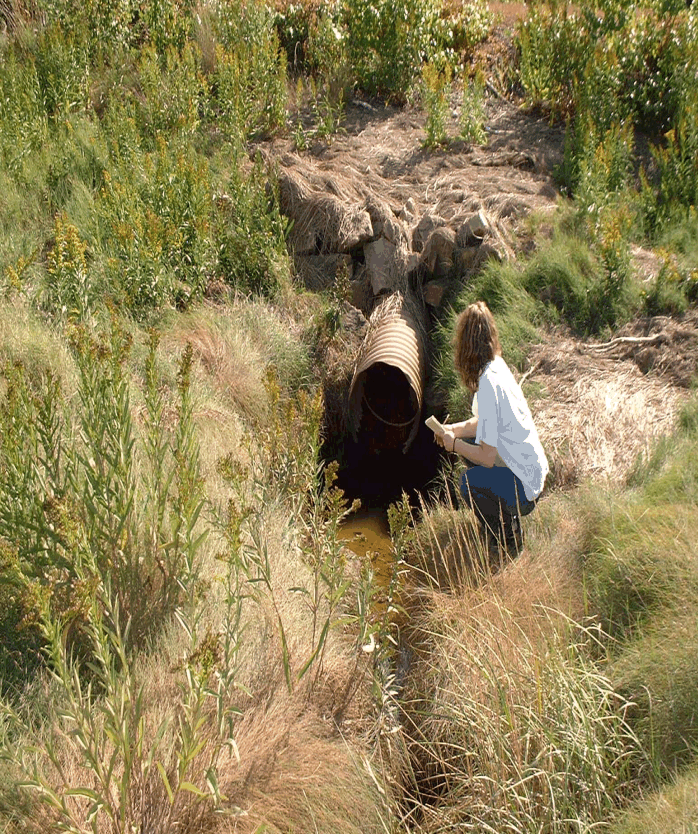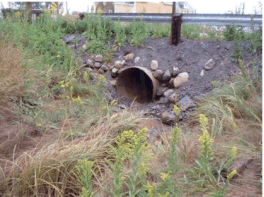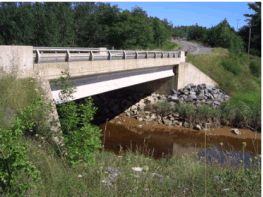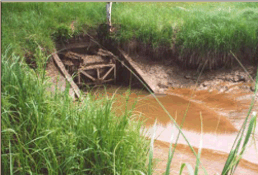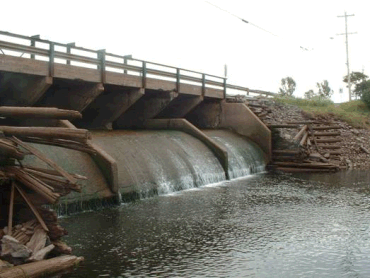|
||||||||||||||||||||||||
|
||||||||||||||||||||||||
|
Introduction | Project Overview | GIS Database Development | Website Introduction | Definitions Over the last century, the majority of rivers entering into the Bay of Fundy have been highly modified through the construction of tidal barriers. The construction of these barriers resulted in either partial or complete obstruction to tidal flow in many areas around the Bay.
Tidal barriers effectively decrease turbulent energy in the tidal system causing sediments and other particles to drop from suspension and accumulate as deposits of mud, sand and silt (Figure 1). In other areas, localized erosion is initiated either directly upstream or downstream of a partially restrictive barrier (Figure 2).
Ecosystems inhabiting this zone, such as mudflats and salt marshes, are some of the first environments to feel the effects of coastal modification. These changes have cascading impacts on intertidal ecosystems (Figure 3), some negative (e.g. loss of spawning and juvenile fish habitat, destruction of salt marsh habitat, siltation) and others positive (e.g. creation of new intertidal habitat downstream of barrier) (Figure 4).
Overall however, the cumulative impacts of tidal barriers on intertidal ecosystems of the Bay of Fundy are unknown. This is of particular concern with increasing interest in removing or modifying tidal barriers in an effort to ‘return the tides’. Without a solid baseline of past and present ‘states’ of these systems, assessing or predicting the success of restoration activities is difficult.
Figure 4: Productive salt marsh located downstream of Windsor causeway which evolved from bare mudflat surface in less than 15 years (D. van Proosdij, 2004).
Tidal Barriers Audit Conducting a Tidal Barriers Audit is an important first step in the restoration process. The purpose of an audit is to assess whether the daily natural tidal flow to rivers and salt marshes is blocked or restricted and to identify sites that would be suitable candidates for restoration. An audit was initiated for New Brunswick in 2000 by the Conservation Council of New Brunswick (CCNB) and Environment Canada and joined on the Nova Scotia side by the Ecology Action Center (EAC) in 2001. In addition, in 2001 the Salt Marsh and Restricted Tidal Systems (SMARTS) Working Group of the Bay of Fundy Ecosystem Partnership (BoFEP) provided scientific support and expertise. Please refer to PROJECT PARTNERS section for funding sources.
The audits consisted of three phases and was modified the Parker River Clean Water Association’s Tidal Crossing Handbook (Puriton and Mountain, 1998) with adjustments made to compensate for the large tides in the Bay of Fundy. 1) Inventory and Visual Assessment: site field visits and recording of visual indicators of restriction (e.g. type and condition of barrier, scour, siltation, differences in vegetation) (Figure 5) 2) Quantitative Data Collection on Tidal Range: field measurements of flow through restriction. Theoretically, non-restrictive crossings should have similar upstream and downstream tidal levels throughout the monitoring period indicating that water was able to move freely through the opening at all times. Those that are restrictive will have upstream and downstream tidal levels that differ at any time by more than ten centimetres. 3) Recommendation and Report Writing: Compilation of data, recommendation of sites for restoration and assessment of feasibility of restoration project. More detailed information regarding the audit process, methodology and report files can be found in the ‘LINKS” section. At the present time only the Nova Scotia Fact Sheets have been completed and are available on-line, however readers are urged to consult the CCNB website for information regarding their Return the Tides Campaign and assessment of select sites for New Brunswick. Bay of Fundy Tidal Barriers GIS Database Development A collaborative research project was initiated in 2004 by the Department of Geography at Saint Mary’s University and the Environmental Conservation Branch of Environment Canada Atlantic Region to develop a comprehensive digital spatial database to integrate a series of environmental indicators over time, which can serve as a baseline to assess the cumulative impacts of tidal barriers in the Upper Bay of Fundy. A key component of that project was to integrate the Bay of Fundy Tidal Barrier Audits into a comprehensive digital spatial database and to make the results of the audit available on-line to the public. Together, they will be used as a baseline to assess the cumulative impacts of tidal barriers in the Upper Bay of Fundy and serve as a platform for future research as well as provide much needed background information for future salt marsh restoration projects. The GIS database was developed at the Maritime Provinces Spatial Research Center (MP_SpARC) at Saint Mary’s University using ArcGIS software and continues to grow as new data become available. All data have been mosaicked and transformed to a common coordinate system. At the present time, the Southern Bight of the Minas Basin (Figure 12) serves as the primary study area for more detailed analysis however geospatial data are also available for all of NS and NB. Types of data include: 1:10,000 topographic map sheets, aerial photography.(where available), property PIDs, coarse resolution digital elevation models, watersheds and tidal barrier shapefiles (including detailed attribute information regarding type of crossing, river, etc..). These data may be available for research however will be subject to individual licensing restrictions. Please contact Dr. Danika van Proosdij, Saint Mary’s University (dvanproo@smu.ca) for more information and access to the database. More detailed information about the project and complete project report can be accessed in the ‘LINKS” section. This site has been developed as a pilot project to demonstrate the effectiveness of on-line delivery of summative information regarding the state of individual tidal barriers in the Bay of Fundy. This information would be useful for managers, researchers, community groups and landowners. More detailed information regarding the project and audit development can be found in the accompanying .pdf report file available in the links section. At the present time, fact sheets are only available for download for Nova Scotia, with detailed information for the Southern Bight. However, information regarding a select group of tidal barriers in New Brunswick is available via the Conservation Council of New Brunswick Return the Tides web site. How to access fact sheets: Fact sheets may be accessed interactively on an individual basis by navigating through the Maps and Tidal Barrier Fact Sheets section and selecting the barrier or geographical area of interest directly on the map displayed. Clicking on the individual point symbol for the barrier will link directly to the corresponding fact sheet in .pdf format. Point IDs correspond to barrier codes identified in the corresponding Tidal Barrier Audit reports prepared by the Ecology Action Center. Alternatively, fact sheets may be downloaded as a group by County or by selecting barriers by name. Tidal Barrier: “any physical obstruction constructed across a tidal water body that restricts tidal fluctuations in all or part of the water body above and/or below the obstruction” (Wells, 1999). Barriers may be classified as Fully Restricted (no tidal flow but may have freshwater discharge), Partially Restricted (some tidal flow upstream but reduced volume of water able to pass through structure) or No Restriction.
Culverts:
Pipes which run underneath road crossings to accommodate water flow
from one side of the crossing to the other (Figure 6). Degree of restriction
affected primarily by size and condition of structure as well as position
relative to the stream bed.
Figure 6: Culvert located at site HCMB 14 C, Avondale, Southern Bight, NS (EAC, 2003).
Bridges: Road crossings over a body of water with support structures on either side of the stream bed and often in the stream itself. Erosion and/or sedimentation may result due to the location of the support structures (Figure 7).
Causeways:
Causeways are raised roads which span a body of water. Although some
causeways may have openings such as culverts, bridges, sluices or gates
to allow tidal flow others can completely block the water body, causing
considerable erosion and sedimentation. Dykes and Aboiteaux: A dyke is an embankment, long ridge or dam which was built primarily to prevent flooding of agricultural land. An aboiteau is small wooden tunnel with a hinged door inside built into a dyke which will allow fresh water to drain out and closes to keep out the tide (Figure 7). Modern versions in reconstructed dykes use concrete, long sluices with waterways, and steel, bronze or Armco gates (Wells, 1999).
Water Control Structures: Water control structures are typically referred to as dams and built in streams and river beds to control the downstream movement of water (Figure 9).
Figure 9: Sluice gate in causeway
in Parsbarro (EAC, 2003). Copyright © 2005 by BoFEP, GOMC, EC and SMU Permission must be obtained from either J. Percy /BoFEP(communications@bofep.org) or M. Tremblay /GOMC(mlt@naturesource.net) for any reproduction of material contained within this website. All materials must be properly cited. |
||||||||||||||||||||||||

